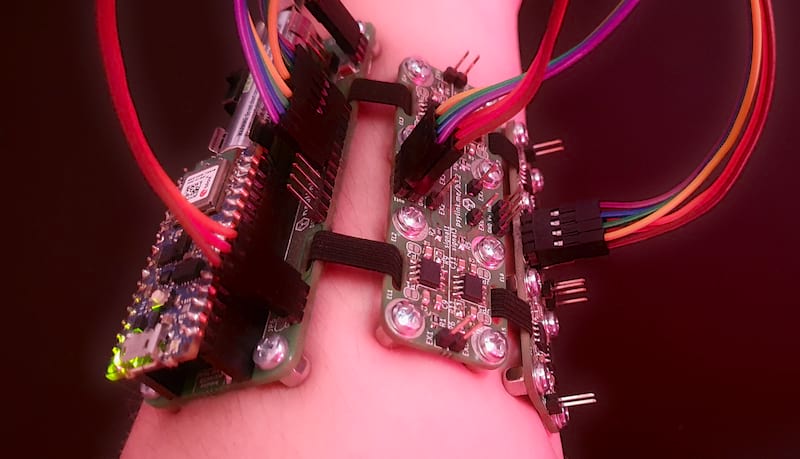3 releases (breaking)
| 0.3.0 | Sep 4, 2024 |
|---|---|
| 0.2.0 | Sep 1, 2024 |
| 0.1.0 | Aug 22, 2024 |
#55 in Accessibility
4MB
62K
SLoC
PsyLink
Open source EMG neural interface.
Website :: Documentation :: Matrix Chatroom :: FAQ

Introduction
Psylink is intended as a human input device (like a keyboard) that predicts your intention from muscle signals. Using a neural network, trained through a process where you press keys at the exact same time that you make movements with the limb wearing the device, it learns correlations between the muscle signals and intended keys, and can press them for you.
Software used to create/edit/run these files
- Schematics, PCB Layouts: KiCad 6.0 (some archived ones used 5.1.5)
- Arduino IDE 1.8.19
- ArduinoBLE 1.2.1
- Arduino_LSM9DS1 1.1.0
- Python 3.8
- For library versions, see the respective requirements.txt file
- GnuRadio 3.8.1.0
Datasheet
This describes prototype 4.

- Features:
- Battery-powered
- Wireless, using Bluetooth Low Energy (BLE)
- Supports 17 electrodes (8 pairs + 1 ground)
- Transmits 8 signals at 8-bit resolution, 500Hz sampling rate
- Linux graphical user interface for:
- Mapping keyboard key presses to muscle signals
- Training a neural network to predict key presses from signals
- Simulating key presses based on neural network predictions
- GNURadio integration for plotting the raw signals + FFT
- Hardware overview:
- A fabric glove/sleeve with a central component (arduino + power supply) and 8 distributed signal clean-up units close to individual electrodes.
- KiCad Schematic
- KiCad PCB of one distributed signal clean-up unit
- Software dependencies:
- Python3 (see requirements.txt)
- BLE-GATT
- matplotlib
- pynput
- tensorflow
- Pillow
- possibly the
python3-pil.imagetkpackage
- ArduinoIDE
- ArduinoBLE
- Arduino LSM9DS1 (for accelerometer/gyroscope)
- Python3 (see requirements.txt)
- Components:
- 1x Arduino Nano 33 BLE Sense
- 1x LM324 Operational Amplifier
- 8x INA128 Instrumentational Amplifier
- Any portable 6V power supply (like 2x CR2032)
- 17x Electrodes, e.g. Prym 390120 (don't laugh, they work)
- A forearm sleeve from non-conductive fabric
- Additional standard components (see schematic)
- Power ratings
- Supply Voltage: 4.5-6V
- Power dissipation:
- Idle: ~86.9mW (16.9mA x 5.14V)
- Transmitting at 6-7kB/s: 92.5mW (18.0mA x 5.14V)
- Weight: ~85g (at 9.81m/s² gravitational acceleration)
Acknowledgements
Very special thanks to every contributor. You all shaped the direction of this project in your unique way, and we would not be at this point without you!
- Roman Zimbelmann: Founder and maintainer of PsyLink
- Alex Lao: Consulting
- AntonX: Consulting, hardware design
- Cade Brown: Testing, financial support
- Fabien Devaux: Consulting
- Farzam Khodajoo: Consulting, hardware design
- Hackaday.com: Spreading the word, networking
- John Shahbazian: Consulting, testing, software, financial support
- keks: Consulting, testing
- knoc: Consulting, testing
- ktrask (mastodon): Consulting, testing
- PCBWay: Sponsored production services
- PerlinWarp: Consulting, testing, documentation, networking, financial support
- PrototypeFund: Consulting, financial support
- Ricard Collins: Consulting, financial support, testing
- Wojciech Siewierski: Consulting
- Thanks to all the patrons on Liberapay for financial support!
License
Copyright (C) 2024 Roman Zimbelmann
This program is free software: you can redistribute it and/or modify it under the terms of the GNU General Public License version 3 as published by the Free Software Foundation.
This program is distributed in the hope that it will be useful, but WITHOUT ANY WARRANTY; without even the implied warranty of MERCHANTABILITY or FITNESS FOR A PARTICULAR PURPOSE. See the GNU General Public License for more details.
You should have received a copy of the GNU General Public License along with this program. If not, see https://www.gnu.org/licenses/.
Dependencies
~65–115MB
~2M SLoC